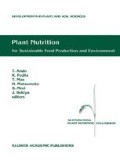Abstract
Growthroom and field studies were used to study the physiology of the onset of K deficiency in cotton (Gossypium hirsutum L.) in order to explain the poor yield response to foliar-applied K fertilizer. This report describes studies conducted in Arkansas on the K nutrition of cotton. Initial studies documented the partitioning of K in plant components during the season. The onset of K deficiency in growth chamber experiments was first detected in roots, followed by stems, petioles and leaves, and then in the fruit. Furthermore, luxury storage of K, prior to peak demand for K by the boll load, could complicate tissue diagnostic recommendations. Visual K deficiencies were first observed in growth chamber experiments 19 days after K was withheld, along with reductions in leaf chlorophyll concentration and significant reductions in leaf photosynthesis. However, leaf ATP and nonstructural carbohydrate concentrations were higher 19 and 26 days after withholding K than in the control, which may have been the result of reduced utilization and translocation of these metabolites. Carbon isotope analyses, and analysis of carbon isotope discrimination, indicated that the most limiting resistance to net photosynthesis was stomatal, but that non-stomatal limitations became more important as the K stress developed. Our studies show that reductions in leaf physiological processes and plant growth did not occur until the petiole K concentration fell below 0.88% on a dry weight basis. Therefore, reductions in lint yield and quality should not develop until this critical petiole level is attained. This information will improve our understanding of tissue diagnosis for a pending K deficiency. Results from these studies were used to explain the inconsistent response of cotton to foliar-applied K fertilizer.
Access this chapter
Tax calculation will be finalised at checkout
Purchases are for personal use only
Preview
Unable to display preview. Download preview PDF.
References
Baker W H, McConnell J S, Maples R L and Varvil J 1992 Soil and plant methods for diagnosing K deficiency in cotton. In Proc. Beltwide Cotton Production Res. Conf., pp 67–70. National Cotton Council, Memphis, Tennessee.
Bednarz C W 1995 Partitioning of potassium in cotton (Gossypium hirsutum L.) during the development of potassium deficiency symptoms. Ph. D. Dissertation. Univ. of Arkansas, Fayetteville.
Bednarz C W and Oosterhuis D M 1996 Partitioning of potassium in the cotton plant during the development of a potassium deficiency. J. Plant Nutr. 19, 1629–1638.
Bennett O L, Rouse R D, Ashley D A and Doss B D 1965 Yield, fiber quality and potassium content of irrigated cotton plants as affected by rates of potassium. Agron. J. 57, 296–299.
Cope J T Jr 1981 Effects of 50 years of fertilization with phosphorus and potassium on soil test levels and yields at locations. Soil Sci. Soc. Amer. J. 45, 342–347.
Evans H J and Sorger G J 1966 Role of mineral elements with emphasis on univalent cations. Annu. Rev. Plant Physiol. 17, 47–76.
Hartt C E 1970 Effect of potassium deficiency of two cotton cultivars grown under irrigation. Agron. J. 68, 701–705.
Hsu H H, Lancaster J D and Jones W F 1978 Potassium concentration in leaf-blades and petioles as affected by potassium fertilization and stage of maturity of cotton. Commun. Soil Sci. Plant Anal. 9, 265–277.
Huber S C 1985 Role of potassium in photosynthesis and respiration. In Ed. R.D. Munson. Potassium in Agriculture. pp 369–396. Am. Soc. Agron., Madison, WI.
Kafkafi U 1990 The functions of plant K in overcoming environmental stress situations. In Proceedings 22nd Colloquium, International Potash Institute, Bern, Switzerland. pp 81–93.
Oosterhuis D M 1995 Potassium nutrition of cotton in the USA with particular reference to foliar fertilization. In Proc. World Cotton Research Conference. Eds. C A Constable and N W Forrester. pp 133–146. CSIRO, Brisbane, Australia.
Rosolem C A and Mikkelsen D S 1991 Potassium absorption and partitioning in cotton as affected by periods of potassium deficiency. J. Plant Nutr. 14, 1001–1016.
Author information
Authors and Affiliations
Editor information
Editors and Affiliations
Rights and permissions
Copyright information
© 1997 Kluwer Academic Publishers
About this chapter
Cite this chapter
Oosterhuis, D.M., Bednarz, C.W. (1997). Physiological changes during the development of potassium deficiency in cotton. In: Ando, T., Fujita, K., Mae, T., Matsumoto, H., Mori, S., Sekiya, J. (eds) Plant Nutrition for Sustainable Food Production and Environment. Developments in Plant and Soil Sciences, vol 78. Springer, Dordrecht. https://doi.org/10.1007/978-94-009-0047-9_102
Download citation
DOI: https://doi.org/10.1007/978-94-009-0047-9_102
Publisher Name: Springer, Dordrecht
Print ISBN: 978-94-010-6510-8
Online ISBN: 978-94-009-0047-9
eBook Packages: Springer Book Archive

